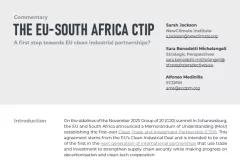The future of natural gas is limited, even as a bridging fuel. Continued investments into the sector create the risk of breaching the Paris Agreement’s long-term temperature goal and will result in stranded assets, the Climate Action Tracker (CAT) said today.
As part of its decarbonisation series, the CAT today released an examination of gas in the power sector. The report, titled “Foot off the gas: increased reliance on natural gas in the power sector risks an emissions lock-in”, warns that natural gas will have to be phased out along with coal, if the world is to limit warming to 1.5˚C, as spelt out in the Paris Agreement long term temperature goal.
The CAT foresees a dwindling role for natural gas in the power sector toward the middle of the century, not only to meet the Paris Agreement goals, but also due to increasing competition from renewables.
This outlook challenges projections that forecast an increase in natural gas consumption. Although these projections have proven too bullish in the past, governments and companies are staking significant investments in natural gas infrastructure on them, ignoring the increasing role of low-carbon alternatives, and the need to reduce emissions to combat climate change.
“Natural gas is often perceived as a ‘clean’ source of energy that complements variable renewable technologies. However, there are persistent issues with fugitive emissions during gas extraction and transport that show that gas is not as ‘clean’ as often thought,” said Bill Hare of Climate Analytics. “Natural gas will disappear from the power sector in a Paris Agreement-compatible world, where emissions need to be around zero by mid-century.”
Although the emissions from gas plants can be reduced by up to 90% with Carbon Capture and Storage (CCS), this is not sufficient for full decarbonisation. Even if these capture rates could be increased, ultimately, the cost of gas with CCS is unlikely to be competitive with renewables and a flexible grid, the CAT said.
“The idea of a continuing role for natural gas as a bridging technology is not consistent with the reality of advances in flexibility enabling technologies, such as grid expansion, supply and demand response, as well as storage,” said Yvonne Deng of Ecofys, a Navigant company.
Many projections for the use of natural gas—including from the International Energy Agency, investors, and many governments—not only fail to consider the need for complete decarbonisation within three decades, but they also ignore the increasing role of low-carbon alternatives.
“One example is China, where in 2016 the IEA projected renewables would rise to 7.2% of the power supply by 2020—but by the end of 2016 they had already reached 8%. Additionally, India and the Middle East are also seeing renewables rising much faster than mainstream projections,” said Niklas Höhne from NewClimate Institute.
Despite these developments, massive investments into LNG pipelines and terminals continue, even as the utilisation rates of such infrastructure are decreasing. For example, utilisation rates in US natural gas infrastructure are at 54%, and are even lower in Europe at 25%.
“This overinvestment in natural gas infrastructure is likely to lead to either emissions overshooting the Paris Agreement’s 1.5°C and 2°C goals—or a large number of stranded assets as the shift to cheaper renewables takes place, “ said Andrzej Ancygier of Climate Analytics.
About the CAT decarbonisation series






